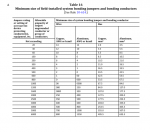The FR should be rejected on lack of need, lack of technical substantiation, and the
resultant decrease in safety. There is no reason given or implied that making such a
drastic change is needed. No information is provided to indicate the existing Table
250.122, based on the size of the overcurrent device, is wrong, inadequate, or
confusing, or that this change will be an improvement. In fact, the existing Table is
simple and straightforward and has been proven safe for decades.
The Panel statement only says that the Table is being changed but does give any technical reason for doing
so. The use of a UL Standard for MC cable and TC cable is not representative of all
installations or conditions: it addresses a specific, tightly controlled factory
manufactured wiring method, in which the equipment grounding conductor is installed
within a jacket in a determined location/configuration. This concept cannot possibly be
valid for all configurations where the proximity of the EGC to the phase conductors is
random, as in a trench, wireway, or raceway. The physics of these installations should
not be assumed to be the same as for construction of specific cables. It needs to be
noted that these standards were not made available to the Panel at time of the Public
Input, nor during the deliberations during the PI hearings; only a few minutes was
offered to a few CMP-5 members. This in itself should disqualify the change due to lack
of ability to review the standards for relevancy. The comment that this action is
consistent with sizing of supply-side bonding conductors and grounded conductors in
Table 250.102(C)(1) is not accurate, as those conductors generally do not have an
known overcurrent protection. Only the protective device applied by the utility is
applicable, and is not controlled by the NEC and often will not come close to protecting
a conductor sized per the NEC. The hope is that the supply-side bonding jumper will
survive long enough to open some device on the utility side of the premises wiring, or
possibly until the shorted conductor burns through.

~RJ~



